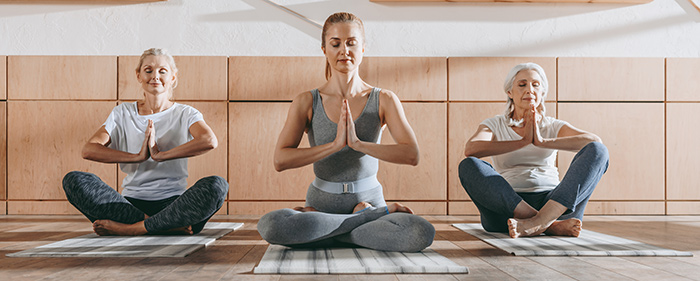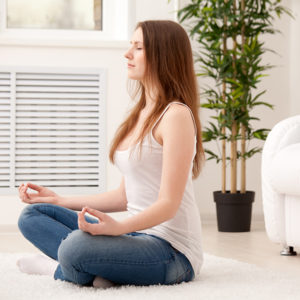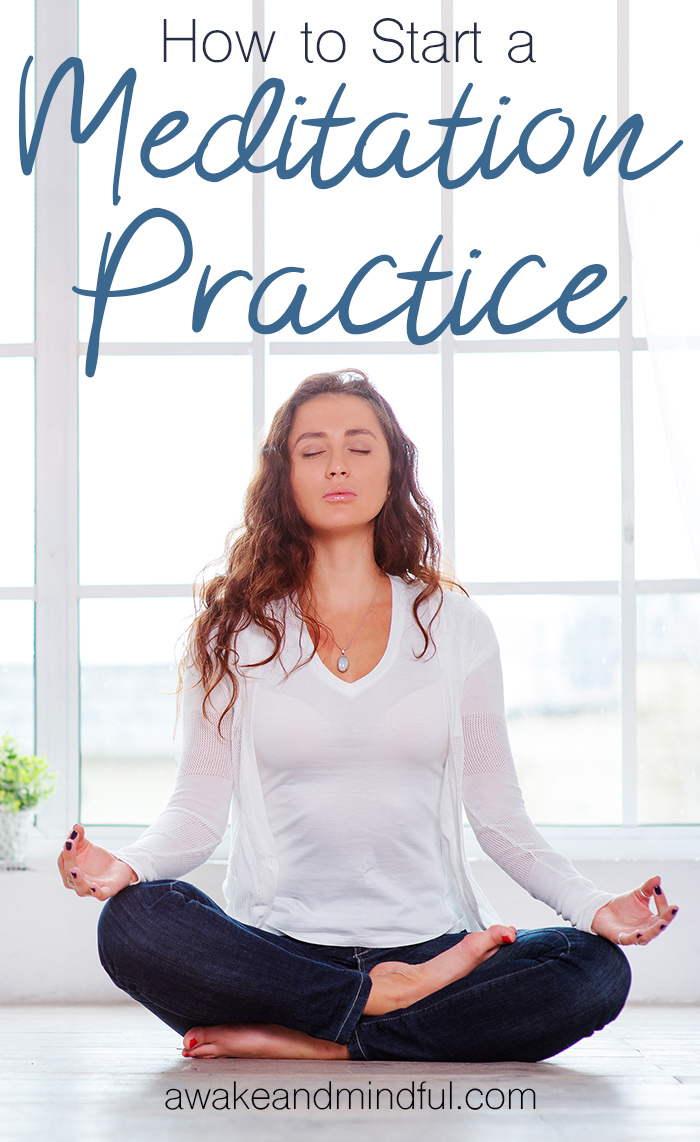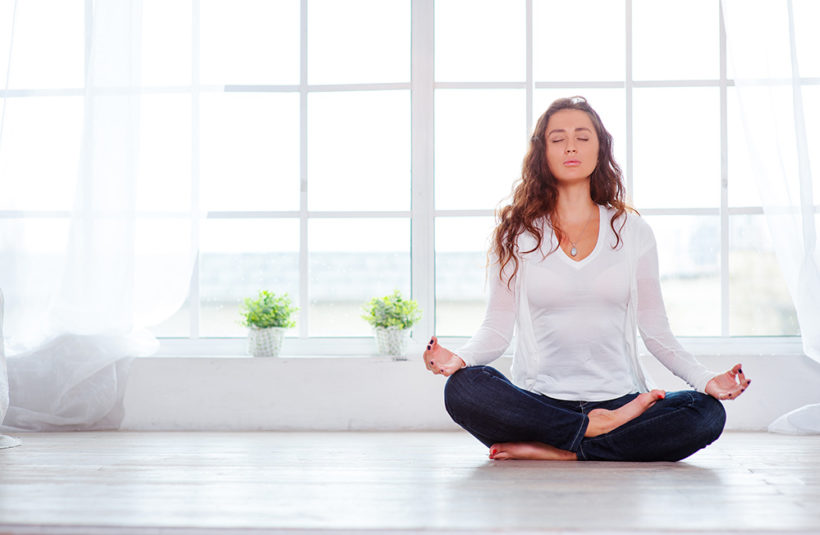How to Start a Meditation Practice
So you’ve finally decided you want to give meditation a whirl. Now you’re probably thinking, “how do I start meditating?” Luckily, it’s as simple as sitting down, closing your eyes, and focusing on your breath. Unfortunately, starting a meditation practice and incorporating it into your daily life is a little more challenging. Just like building any new habit, it requires discipline and focus. But with each day of practice, meditation will become easier and you’ll feel the vast benefits in your life.
The great thing about meditation is you can start meditating with little to no monetary investment and reap the benefits immediately. This page is a crash course guide for how to start a meditation practice. It’ll answer many questions newcomers have about meditating and give you some advice on how to meditate and start a consistent practice. If you’re searching for an in-depth guide to meditation, check out our recommended meditation books for beginners.
How to Start a Meditation Practice
Contents
What do you Think About When you Meditate?
Many people assume that meditating involves turning off your mind so it’s completely blank. As cool as that would be, there’s no off switch for your mind. Instead, meditation is about focusing your attention and establishing healthy relationships with the thoughts in your mind. The type of meditation you choose to practice will determine what you focus your mind on. You can use a variety of meditation types depending on your needs each day, but I have few recommendations for beginners to try.
One of the more common types of meditation, shamatha, instructs you to focus on your breath. Whenever a new thought pops into your head, direct your attention back to your breath. Focus on the inhales and exhales. Shamatha is great for calming an anxious mind or reducing stress. Another common meditation type, mindfulness meditation, doesn’t instruct you to focus your mind on anything in particular. Instead, you let your attention wander freely and without judgment as you observe where it goes. Not surprisingly, this type of meditation helps make you more “mindful.” If you’re using a guided meditation for your session, focus your mind on the instructions it gives you. Shamatha meditation, mindfulness meditation, or guided meditations are usually the easiest for beginners to try as they start their journey.
How to Meditate Step by Step
1. Designate a Meditation Space
 Pick a spot in your home to make your “meditation space.” This can be an entire room or just an area that you designate for meditation. It should be a quiet area, without distractions. Clear it of clutter and make sure electronics that like to steal your attention (smartphones, computers, etc.) are either shut off or in another room. This should also be a place where you will not be disturbed while you meditate. If you have pets, kids, or partners who often seek your attention, a room with a door can help keep the chaos out of your meditation time (make sure to tell any family members or roommates about your new meditation goals so they can help support you and avoid interrupting your sessions).
Pick a spot in your home to make your “meditation space.” This can be an entire room or just an area that you designate for meditation. It should be a quiet area, without distractions. Clear it of clutter and make sure electronics that like to steal your attention (smartphones, computers, etc.) are either shut off or in another room. This should also be a place where you will not be disturbed while you meditate. If you have pets, kids, or partners who often seek your attention, a room with a door can help keep the chaos out of your meditation time (make sure to tell any family members or roommates about your new meditation goals so they can help support you and avoid interrupting your sessions).
That’s all you need to start your meditation practice. You can make your meditation space even more special by adding calming elements to support your practice. Candles, incense, and essential oils can help enhance your meditation with aromatherapy.
2. Set a Timer
Decide how long you would like to meditate for. As a beginner, five minutes is a great goal for your first couple of meditation sessions. Use your phone, an alarm clock, or kitchen timer to alert you of the end of your session. (I do recommend setting the timer for 2 minutes longer than you intend to meditate to allow time for your body and mind to settle.)
If you don’t want to be jarred out of your meditation by a loud alarm, consider using a mindfulness bell app or a meditation app to time your sessions. There’s also a variety of online meditation timers like this one.
If you are using a guided meditation, a timer is unnecessary.
Mala meditation beads are another option to help you “time” your meditation. With each breath, you count your way around the beads until you reach the tassel. You can do as many “rounds” as you like to extend your meditation session.
3. Sit Down

There are a variety of ways to sit for meditation. What’s most important is to find a technique that is comfortable and does not cause any pain. It’s recommended to sit on the floor or as close to the floor as possible while you meditate to help you stay grounded. A common meditation option is sitting in lotus position (pictured above, center), cross-legged with the feet resting on the opposite thighs. Lotus position can also be modified depending on your flexibility as shown by the women on the left and right. Lotus is a great meditation posture for beginners since it is so easily modified to sit in a comfortable cross-legged position. You can use a blanket, pillow, or cushion to sit on hard floors more comfortably.
Kneeling meditation is another option, where you can kneel on the floor (or a blanket or cushion). This position is a little more difficult to hold for long periods and usually requires practice or using props like a meditation bench to make it more comfortable. There are also a variety of ergonomic meditation chairs and cushions to make sitting more comfortable.
If you can’t comfortably sit on the floor, consider using a floor chair with back support or a regular chair to sit normally.
Laying down is also an option for meditation, especially if you choose to meditate before bed. One thing to note is that if you choose to lay down to meditate during the day, you do run the risk of falling asleep.
4. Sit Tall
Once you’ve decided how you want to sit and what props you need to make it comfortable, all you need to do is sit tall. Your back, neck, and head should form a straight line extending to the ceiling. Keep awareness in your posture to make sure you sit tall throughout your practice. This will help you avoid pain and make it easier to breathe.
If you find it difficult to sit tall without support, consider using a meditation chair with back support or sit against a wall or cushion to support your back.
You can rest your hands in your lap or on your knees or hold them in prayer pose. Just pick whatever is most comfortable for you.
5. Relax and Focus
If you plan to use a guided meditation, start it now. Otherwise, close your eyes and scan your body. Starting with your toes, focus on each body part separately and any sensations you feel there. Relax that body part and then move on to your feet, ankle, etc. Once you’ve reached the top of your head, focus on your breathing. If your thoughts wander, acknowledge the thought without judgment and bring your attention back to your breathing.
6. Come Back to Reality
Once your timer goes off or you feel ready to stop, bring your attention back to the room. You don’t want to just jump up and get back to your day. Instead, slowly bring yourself back to awareness. Bring your consciousness to the room and the sounds around you. Wiggle your fingers and toes. When you feel ready, open your eyes. Take a moment to breathe. Eventually, slowly get up and return to your day.
That’s all it takes to start meditating. Now the challenge is to build a consistent meditation habit.
How to Start a Daily Meditation Habit
 While you can feel immediate benefits from one meditation session, including a calm mind and relaxed body, the real benefits come from a daily meditation habit. While the idea of adding meditation to your daily schedule may seem intimidating, remember that you only need to devote a few minutes a day to feel the benefits. It’s the regularity of checking in and being mindful that is important.
While you can feel immediate benefits from one meditation session, including a calm mind and relaxed body, the real benefits come from a daily meditation habit. While the idea of adding meditation to your daily schedule may seem intimidating, remember that you only need to devote a few minutes a day to feel the benefits. It’s the regularity of checking in and being mindful that is important.
You can incorporate meditation into your daily schedule–when you first wake up in the morning or right before bed to help you sleep–or just do it when you need to find a moment of inner peace during a stressful day. Many people find the best success meditating first thing in the morning. They get out of bed, go to their meditation space, and meditate for a set period of time. This is a great way to build it into your morning routine, just like enjoying a cup of coffee, brushing your teeth, and taking a shower. I recommend trying to incorporate meditation into your bedtime routine if you struggle with anxiety or insomnia. A nightly meditation is a perfect way to clear worries from your mind and lull you to sleep. Some people even meditate in bed so they can easily drift off to sleep.
Here are my main tips to successfully start a meditation habit:
1. Pick a time of day that you can meditate for at least five minutes each day. You’ll be more likely to be successful in building a habit if you pick a time that is associated with something else you already do daily. Waking up, going to sleep, before lunch, before going to the gym are all examples of great times to meditate.
2. Create a designated meditation space. Whether this is just a corner where you keep your meditation gear and light a candle or incense or even an entire dedicated meditation room, having a special space will make it easier to get into meditation mode. Just going and sitting in your meditation space will help you, especially on those days where you just don’t feel like meditating. Sitting down will help your body go through the motions and make it easier to calm your mind and focus.
3. Use guided meditations as you’re learning how to meditate and be mindful. These are extremely helpful on days when you feel frantic and unfocused or stress is really getting to you.
4. Track your progress. Keep a log of when you meditate and for how long. You can do this in a notebook or use a habit tracking app on your smartphone. Tracking will help give you positive reinforcement for your habit as well as providing a record of your progress. You can even journal about emotions or feelings you experience while meditating and any changes you notice in day-to-day life.
If you struggle with self-discipline and starting habits, there are gadgets and apps that can help you form a regular meditation practice. On the high end, there are meditation and stress trackers you can buy to help build your habit. They can remind you to meditate, track your stress levels, and even track your meditation for you. There are also a variety of smartphone apps for meditation that feature guided meditations, daily meditation reminders, and other cool features to help build your practice.
Benefits of Regular Meditation
According to The Art of Living there are tons of emotional and physical benefits of regular meditation.
- Reduces stress
- Increases capacity for empathy and compassion
- Lowers blood pressure
- Reduces anxiety attacks through lower levels of blood lactate
- Decrease tension related pain (tension headaches, ulcers, insomnia, muscle & joint issues)
- Improved mood and behavior through increase serotonin production
- Boosts your immune system
- Increases energy levels
- Increased creativity
- Increased happiness
- Increased focus
Now that you’re starting a regular meditation habit, there are plenty of resources to help you on your way. Follow these meditation tips and techniques for beginners. Check out these guided meditation to add variety to your daily practice. These meditation books for beginners will help you deepen your understanding and improve your practice.
Save on Pinterest

